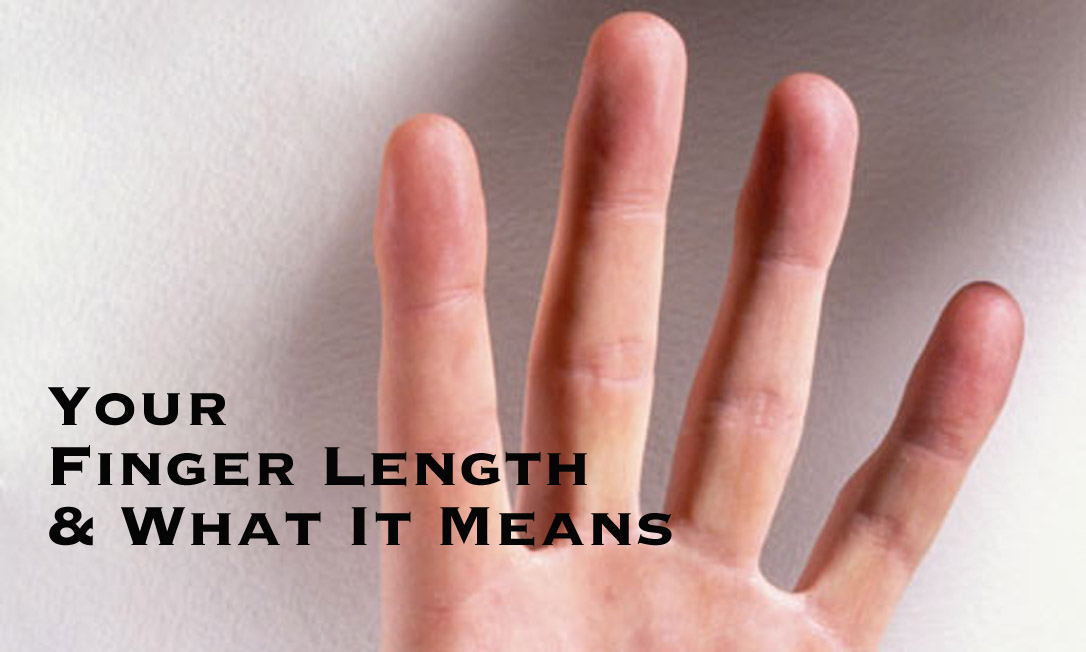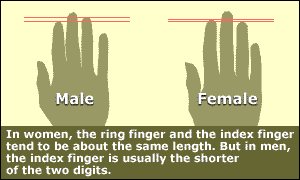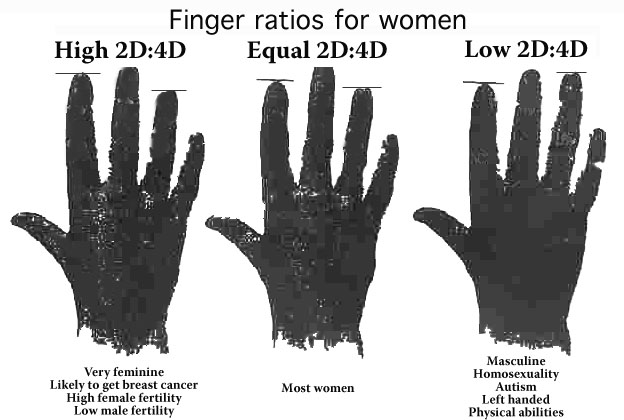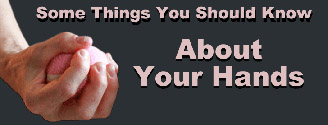

Finger Length Helps Predict Test Exam Results, Homosexuality, Cancer, Musical Ability and Aggressive Personality -- Study Shows
Your finger length can predict how you will do on various tests in school. They can also tell if you are likely to be homosexual or straight, if you will likely get certain cancers, be a musician, writer or a scientist, or if you will have an aggresssive or passive personality.The two fingers that are important are the index finger -- the one you use to point to something -- and the ring finger.
Reading, writing and arithmetic...
In a recent study from the help of online universities, the results of mathematics and literacy (reading) tests for seven-year-old children could be predicted by measuring the length of these two fingers.
 In a study to be published in the British Journal of Psychology, scientists compared the finger lengths of 75 children with their Standardised Assessment Test (SAT) scores. They found a clear link between a child's performance in numeracy and literacy tests and the relative lengths of their index (pointing) and ring fingers.
In a study to be published in the British Journal of Psychology, scientists compared the finger lengths of 75 children with their Standardised Assessment Test (SAT) scores. They found a clear link between a child's performance in numeracy and literacy tests and the relative lengths of their index (pointing) and ring fingers.
Scientists believe that the link is caused by different levels of the hormones testosterone and estrogen in the womb -- and the effect they have on both brain development and finger length. This is nothing new, since scientists have known for many years that elevated levels of testosterone -- or other hormones closely resembling testosterone -- can cause the brains of both males and females to be more "masculine."
It has long been known that boys tend to do better on math tests while girls do better at writing, reading and verbal tests.
"Testosterone has been argued to promote development of the areas of the brain which are often associated with spatial and mathematical skills," said Dr Mark Brosnan, Head of the Department of Psychology at the University of Bath, who led the study.
"Estrogen is thought to do the same in the areas of the brain which are often associated with verbal ability. "Interestingly, these hormones are also thought have a say in the relative lengths of our index and ring fingers.
"We can use measurements of these fingers as a way of gauging the relative exposure to these two hormones in the womb and as we have shown through this study, we can also use them to predict ability in the key areas of numeracy and literacy."
How they did the research
The researchers made photocopies of the palm of the children's hands and then measured the length of their index finger and ring finger on both hands using callipers, accurate to 0.01mm. They then divided the length of the index finger by that of the ring finger -- to calculate the child's digit ratio.
When they compared this ratio to the children's SAT scores, they found that a smaller ratio (i.e. a longer ring finger and therefore greater prenatal exposure to testosterone) meant a larger difference between ability in maths and literacy, favouring math skills relative to reading and speaking skills.
When they looked at boy's and girl's performance separately, the researchers found a clear link between high prenatal testosterone exposure, as measured by digit ratio, and higher numeracy SAT scores in males.

Previously, researchers have found a link between index and ring finger lengths and homosexuality (see article in viewzone.)
They also found a link between low prenatal testosterone exposure, which resulted in a shorter ring finger compared with the index finger, and higher literacy SAT scores for girls.
This, says the scientists behind the study, suggests that measurements of finger length could help predict how well children will do in maths and literacy.
"We're not suggesting that finger length measurements could replace SAT tests," said Dr Brosnan.
"Finger ratio provides us with an interesting insight into our innate abilities in key cognitive areas.
"We are also looking at how digit ratio relates to other behavioural issues, such as technophobia [fear of science], and career paths.
There is also interest in using digit ratio to identify homosexuality, developmental disorders, such as dyslexia, which can be defined in terms of literacy deficiencies, and aggressive vs. passive personalitity traits.
Other interesting observations about finger length:
Bodily characteristics that develop in distinctly masculine and feminine ways are usually the product of sex hormones. Some features differentiate at puberty, such as breasts, muscle development and jaws. But other sex differences are already set by the time we're born, relative finger lengths among them, and seem to be the result of fetal androgens (hormones such as testosterone or related hormones) masculinising the males. some of those hormones come from fetal testes and adrenal glands, the rest make it across the placenta from the blood of the mother. But exactly how much comes from whom -- and what alters the balance -- are still not entirely understood.
"Prenatal development is a black box," says John Manning of the University of Liverpool. He is one of a small number of scientists beginning to wonder if fingers could be used as a way of peering into that "box."
Finger lengths may predict cancer!
In a paper just published in the journal Medical Hypotheses (vol. 54, p 855), Manning highlights conditions such as heart disease, breast cancer, autism and dyslexia. Both heart disease (in men) and breast cancer have been linked with high levels of the female hormones Eestrogen and Progesterone. Most of the studies of this link have looked at circulating levels in the adult, but evidence is mounting that too much of the wrong hormone in the womb, before birth, may be the real culprit.
 Oimitrios Tricopouos, an epidemiologist at Harvard University, proposed a decade ago that breast cancer may originate in the uterus of the mother (The Lancet, vol. 335, p 939). He suggested that high concentrations of estrogen may create a "fertile soil" for cancer to develop later in life. He also thought that variability in estrogen levels during pregnancy may help to explain why breast cancer rates are generally higher in women born to Caucasian mothers compared with those born to Oriental or younger mothers. Recently he and his colleague Karin Michels showed that high birth weight in girls-another sign of high prenatal estrogen levels-was associated with an increased risk of breast cancer.
Oimitrios Tricopouos, an epidemiologist at Harvard University, proposed a decade ago that breast cancer may originate in the uterus of the mother (The Lancet, vol. 335, p 939). He suggested that high concentrations of estrogen may create a "fertile soil" for cancer to develop later in life. He also thought that variability in estrogen levels during pregnancy may help to explain why breast cancer rates are generally higher in women born to Caucasian mothers compared with those born to Oriental or younger mothers. Recently he and his colleague Karin Michels showed that high birth weight in girls-another sign of high prenatal estrogen levels-was associated with an increased risk of breast cancer.
If high estrogen levels are indeed to blame, Manning thinks that high 2D (see illustration) ratios could be used to identify women who are at increased risk of breast cancer. "I don't know of other sexually dimorphic traits that are so stable," he says. "That's what makes it so exciting." He interviewed 118 women in a breast cancer clinic, measured their finger lengths and noted how old they were when the first tumour appeared. "It was earlier if there was a higher ratio," he says.
Finger length linked to left-handedness!
The developing brain is also sensitive to hormones in utero. Knowing this, Norman Geschwind and his graduate student Albert Galaburda, now at Harvard Medical School, made a controversial claim in 1985. They suggested that prenatal testosterone slows the growth of certain areas of the left hemisphere and facilitates the growth of corresponding regions of the right hemisphere. At the time they wondered whether testosterone was partly to blame for such things as left-handedness, dyslexia and autism (Archives of Neurology, vol43,p 428).
Galaburda and his colleagues have since developed a way to induce selective brain damage to the frontal lobe of newborn rats to mimic some of the symptoms of dyslexia. Curiously, while male rats with this kind of damage have trouble responding to rapidly changing sounds -- much like dyslexic humans -- females don't. "We induce the malformations in males and females," he says, "but only the males have trouble."
It is clear that there is a "genetic component" to dyslexia. But Galaburda thinks fetal testosterone plays a role too by reducing plasticity in the young brain, making males, susceptible to brain malformations that females manage to overcome.
Intriguingly, when female rats are given extra testosterone, they too show signs of dyslexia.

Ratios of 2nd digit (index finger) to 4th digit (ring finger).
Manning hasn't yet checked the finger lengths of human dyslexics to see whether they also point to a testosterone link. But he has already checked out the left-handed idea, using a dexterity test. People are not always straightforwardly right or left- handed: many have been trained to use their right hand for writing, even if they are more skilled with the left. So Manning and his colleagues tested how quickly 285 children could move 10 pegs from one row of holes to another row five inches away, using one or the other hand.
Children with low 2D:4D ratios (see illustration) are believed to have high exposure to testosterone in the womb and are more likely to be quicker with their left hands than the kids with higher ratios. This, he says, suggests that our degree of left-handedness (and more generally the way the brain divides up tasks between left and right hemispheres) may be influenced by hormone levels in the womb.
Finger Length & Autism
 Manning has begun examining autism too. He teamed up with Simon Baron- Cohen and Svetlana Lutchmaya from the University of Cambridge, who have used samples of amniotic fluid to directly measure the levels of hormones that babies are exposed to in the womb. When the children reached their first birthday, the researchers measured their vocabularies and ability to make eye contact. Poor language skills and an unwillingness to make eye contact are early hallmarks of autism. They found that babies who'd been exposed to high levels of testosterone in the womb fared the worst.
Manning has begun examining autism too. He teamed up with Simon Baron- Cohen and Svetlana Lutchmaya from the University of Cambridge, who have used samples of amniotic fluid to directly measure the levels of hormones that babies are exposed to in the womb. When the children reached their first birthday, the researchers measured their vocabularies and ability to make eye contact. Poor language skills and an unwillingness to make eye contact are early hallmarks of autism. They found that babies who'd been exposed to high levels of testosterone in the womb fared the worst.
"What we're hoping to look at is whether finger ratios can be used as a proxy for hormones," says Lutchmaya. Amniocentesis (sampling the amniotic fluic surrounding the unborn baby) is a risky procedure that only a few mothers choose to undergo, she says. But by measuring finger lengths instead, researchers can assess a random sample of children for possible early signs of impaired language and social skill development. Currently, they are checking the fingers of children for whom they have amniotic samples.
Meanwhile, Manning and Baron-Cohen have looked at the finger ratios of 49 children with firm diagnoses of autism, 23 with a mild form of the disorder called Asperger's syndrome, and their families. The researchers found that autistic children tended to have very low 2D:4D ratios (see illustration). Interestingly, children with Asperger's syndrome had ratios that fell between those of autistics and unaffected children. "It fits exceptionally well with the theory," says Manning.
Clearly genes play a role too in these conditions. But could fetal hormone levels explain other cognitive differences between the sexes? Janel Tortorice at Rutgers University in New Brunswick, New Jersey, thinks they may. She has measured finger ratios in 2D:4D ratio (see illustration) gay women and found that their hands were significantly different from those of heterosexual women-in fact, they tend to resemble those of heterosexual men.
But she has also found differences in the way these women's brains work. "They have more masculine fingers and more masculine cognition," she says. On tests of spatial and verbal ability, lesbian volunteers perform more like men than heterosexual women, she says. If this can be confirmed by further studies, perhaps Manning's most recent suggestion is not as outrageous as it sounds. He claims that musical talent, too, is nurtured in the womb.

and Homosexuality

Clenching Your Right Fist Improves Memory
So often we take our hands for granted. Consider how many portraits and photographs focus on out head while a majority of what we do and who we are -- our work and expression -- is the result of our contact with the outside world through our hands. More than any other part of our body, our hands are anatomical structures that create and maintain civilization. Before there was spoken language, there were gestures and hand signs.
What do we really know about our hands?
Ruth Propper and colleagues from Montclair State University have just published a paper in the journal, PLOS ONE (April 2013), which demonstrates the previously unknown use of hands in improving memory.
Participants in the research study were split into groups and asked to first memorize, and later recall words from a list of 72 random words. It's a daunting task under normal circumstances, unless you are a trained memory expert, which the participants were not.
In the experiment there were 4 groups who clenched their hands; One group clenched their right fist for about 90 seconds immediately prior to memorizing the list and then did the same immediately prior to recollecting the words. Another group clenched their left hand prior to both memorizing and recollecting. Two other groups clenched one hand prior to memorizing (either the left or right hand) and the opposite hand prior to recollecting. A control group did not clench their fists at any point.
So what happened?
The group that clenched their right fist when memorizing the list and then clenched the left when recollecting the words performed better than all the other hand clenching groups.
According to Ruth Propper, lead scientist,
"The findings suggest that some simple body movements -- by temporarily changing the way the brain functions -- can improve memory. Future research will examine whether hand clenching can also improve other forms of cognition, for example verbal or spatial abilities."
The authors say that further work is needed to test whether their results with word lists also extend to memories of visual stimuli like remembering a face, or spatial tasks, or where keys, iPhone or the TV remote were placed. Based on previous work, the authors suggest that this effect of hand-clenching on memory may be because clenching a fist activates specific brain regions (left prefrontal cortex) that are also associated with memory formation.
But we can all try this experiment for ourselves. Here's how:
* Get a any magazine or newspaper article and black out any names or places in the text.
* Select a number, say 5, and then copy every 5th word to a paper until you have a few dozen. The experiment used 72 words but your list can vary.
* Use this list as your more-or-less "random" list and try the above experiment with your friends and family.
Some interesting questions are how the test results vary in left-handed v. right-handed individuals... maybe you can find a difference. But remember to have a control... someone who performs the test without making a fist. Compare the results. Let me know what you find.
Clenching Left Hand Helps Athletes Avoid Choking Under Pressure
Some athletes may improve their performance under pressure simply by squeezing a ball or clenching their left hand before competition to activate certain parts of the brain, according to new research published by the American Psychological Association.
One doesn't have to be an athlete to have stress in today's world so this research should interest anyone who has to "get it together" and function at their peak levels.
In three experiments with experienced soccer players, judo experts and badminton players, researchers in Germany tested the athletes' skills during practice and then in stressful competitions before a large crowd or video camera.
Right-handed athletes who squeezed a ball in their left hand before competing were less likely to choke under pressure than right-handed players who squeezed a ball in their right hand. The study was published online in the Journal of Experimental Psychology: General (September 2012).
Juergen Beckmann, PhD, chair of sport psychology at the Technical University of Munich in Germany, explains the phenomenon.
"Rumination (i.e. thinking too deeply about their performance) can interfere with concentration and performance of motor tasks. Athletes usually perform better when they trust their bodies rather than thinking too much about their own actions or what their coaches told them during practice. While it may seem counterintuitive, consciously trying to keep one's balance is likely to produce imbalance, as was seen in some sub-par performances by gymnasts during the Olympics in London."
Essentially, Dr. Beckman is saying that athletes should trust their muscle memory and clear their minds by squeezing a ball.
Previous research has shown that rumination is associated with the brain's left hemisphere, while the right hemisphere is associated with superior performance in automated behaviors, such as those used by some athletes. The right hemisphere controls movements of the left side of the body, and the left hemisphere controls the right side. The researchers theorized that squeezing a ball or clenching the left hand would activate the right hemisphere of the brain and reduce the likelihood of the athlete's choking under pressure.
The study focused exclusively on right-handed athletes because some relationships between different parts of the brain aren't as well understood for left-handed people, according to the authors.
In fact, there is quite a spectrum of left-handedness. Some "lefties" only write with the left hand but play golf, hold a bat and do other activities with their right hand. Some left handed people can read backwards or upside down, some can not.
"The research could have important implications outside athletics. Elderly people who are afraid of falling often focus too much on their movements, so right-handed elderly people may be able to improve their balance by clenching their left hand before walking or climbing stairs."
"Many movements of the body can be impaired by attempts at consciously controlling them," he said. "This technique can be helpful for many situations and tasks." -- Beckmann
|
 |